Abstract
PM (particulate matter) emissions from ships are the main sources of marine atmosphere pollution. Controlling the emissions of particulate matter from ships is related to the sustainable development of the shipping industry. To reduce PM emissions from marine four-stroke diesel engines, DPFs are effective. Our results show that DPF had more than 90% capturing efficiency for both the number and mass emissions of PM, and the capturing efficiency for the accumulation mode was higher than that of the nuclear mode. DPF can also significantly reduce the chemical components of PM in marine diesel exhaust gas. The removal efficiencies for OC and EC were 89.7–91.6% and 84.8–92.8%, respectively, with each particle size range showing over 80% efficiency. SO42− was the ion with the highest content, followed by NH4+, NO3−, Na+, NO2−, and Cl−, with their reduced proportions remaining consistent with the removal efficiency of particulate matter. DPF can also effectively reduce PAH content and toxicity. The use of DPF can greatly improve the impact of ship emissions on the marine atmospheric environment. The appropriate DPF with the best performance can be selected according to the exhaust parameters and particle size distributions with different characteristics.
1. Introduction
With the continuous development of the global transportation industry, shipping transportation still dominates [1]. However, an important factor affecting the sustainability development of the shipping industry involves pollutant emissions. Observing the energy structure in the world today, new energy sources continued to emerge, such as fuel cells, LNG, H2, NH3, and methanol. However, no one can perfectly replace conventional fuel within a certain period of time [2,3]. At present, about 90% of marine engines and boilers burn fossil fuels. According to forecasts from relevant institutions: by 2100, the consumption of fossil fuels and biomass fuels will still account for more than 50% of the world’s energy consumption. In the future, for a long time, fossil fuels will still be used as the main fuels for ships, accompanied by the production of many pollutants, including nitrogen oxides, sulfur oxides, PM, carbon dioxide, and volatile organic compounds [4]. The damage to the atmospheric environment and human health cannot be ignored.
Road vehicles generally use four-stroke engines (gasoline or diesel), while the propulsion systems of large ships, such as large tankers, bulk carriers, container ships, and ro-ro ships, widely use low-speed two-stroke diesel engines (60–300 r/min). Auxiliary engines generally use medium-speed four-stroke diesel engines (300–1000 r/min). River fishing boats, engineering ships, and other small- or medium-sized ships mostly use high-speed four-stroke diesel engines (1000–2000 r/min). Marine diesel engine power is generally more powerful, and its fuel quality is poor compared to vehicle engines, resulting in more pollutant emissions. The particulate matter emitted by marine diesel engines is increasingly harmful to the environment and human health, leading to countries and organizations around the world formulating particulate matter emission laws and regulations to limit these emissions [5,6]. Therefore, it is critical to carry out relevant research on particulate matter control technology. Due to the characteristics of marine diesel engines and the limitations of the marine environment, there are certain requirements for the selection of particulate matter reduction technology, as shown in Figure 1. In addition to in-engine measures, the reduction technologies for particulate matter emissions from marine two-stroke diesel engines are usually synchronized with sulfur oxides, mainly through the use of alternative fuels (low-sulfur fuel oil or LNG) and after-treatment technologies [7]. After-treatment technologies mainly include wet scrubbing, electrostatic dust removal, and electrostatic combined with wet scrubbing [8,9]. For marine four-stroke diesel engines, alternative fuels (e.g., LNG, etc.) and after-treatment technologies can be used, with DPF being the main after-treatment technology [10,11].
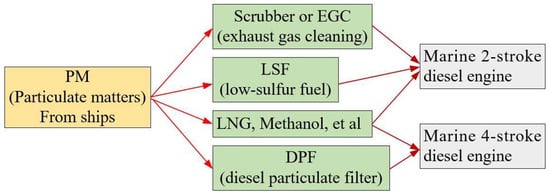
Figure 1.
Marine particulate matter emission control technologies.
DPF is a kind of porous media filter that can capture emission particles before they enter the atmosphere, serving as an effective post-treatment technology to address diesel exhaust particle pollution. DPF technology applied to automotive diesel engines has been well-studied and applied [12]. DPF captures particles mainly through adsorption and regeneration. When the exhaust gas-carrying particulate matter passes through the filter body, the particles are trapped on the surface of the micropore area on the filter wall. As the accumulation time increases, the particles attached to the filter body wall will gradually reduce the micropore sizes and the particle passing rate. However, the back pressure gradually accelerates; the larger the particle size, the more likely it will cause a micropore blockage, resulting in a sharp increase in back pressure. The regeneration of the filter requires certain oxidation measures and temperatures. The fuel quality will also affect its regeneration efficiency. Some research institutions have studied the DPF technology of marine diesel engines. With 5% of the exhaust gas bypassing at a 25% load of an 800 kW marine diesel engine, the capture of particulate matter and regeneration of DPF were studied, and high capture efficiency was obtained [13]. In response to emission regulations, DPF units are often used in conjunction with the selective catalytic reduction (SCR) system to remove PM and NOx from the exhaust gas, with NOx and PM removal efficiencies of 92% and 92–97%, respectively. One DPF experiment was conducted on a tugboat burned with ultra-low sulfur fuel; the study showed a 92% to 97% removal efficiency for PM2.5 [14]. DPF has high particle capture efficiency, but its effect on marine diesel engine performance has also been linked to pressure drop and fuel quality [15,16]. This can be optimized through experiments combined with numerical simulations. When DPF was used in marine diesel engines, the regeneration process was solved. This was related to ash, the fuel type, and ions [17]. The non-flammable component is an important factor affecting regeneration. DPF has high particle removal efficiency; however, DPF has not been applied to ships. There is also no study on non-carbon and non-combustible emission substances from marine engines with DPF, such as ash and sulfate. Other studies focus on DPF capture and regeneration processes in automotive engines. DPF has been studied relatively extensively in motor vehicles. A comparison between old and fresh DPF devices showed that the old DPF had more ash, which affected the back pressure and regeneration progress. The results also showed that NTP technology can enhance the regeneration effect of DPF [18,19]. NTP technology can generate a large number of active radicals in excited states, decompose particles into CO2 and other substances, and realize the purpose of DPF regeneration. DPF usually includes DOC and a filter. DPF can reduce PM emissions and affect the removal of incomplete combustion products, such as CO and HC [20,21]. Moreover, it can reduce CO emissions by 87–93% for gaseous pollutants while HC emissions show reductions of 80.7–100% [22]. With the development of automotive engines, new particulate capture devices have also appeared, such as the use of POC (particle oxidation catalyst) in the DPF. It can efficiently capture particulate matter and further remove PAHs [23]. In addition, passive regeneration technology can reduce the emissions of particulate matter more so than active regeneration, providing a reference for the use of DPF on ships with strong mobility [24]. Generally, the development of automotive diesel engine post-treatment technology can provide a reference for marine diesel engines.
There are relatively few studies on marine DPF (studies have mainly focused on the experimental research or simulation of particle capture efficiency); however, there are a few studies on the application of DPF in marine diesel engines, especially the effect of DPF on the removal of chemical components in particulate matter. Considering the working principles and characteristics of DPF technology, it is suitable for marine four-stroke diesel engines with good fuel quality. However, the use of high-power two-stroke diesel engines on ships is limited due to insurmountable conditions. Based on the capture efficiency, this work mainly studies the influence of DPF on the emission characteristics, capture efficiencies, and size distributions of chemical compositions in PM. This work provides a more detailed study on the emission reduction of particulate pollutants and serves as a supplement to previous studies.
2. Materials and Methods
2.1. Tested Engine and Fuel Parameters
This study was conducted on a marine four-stroke diesel engine bench. The experiment began with a fresh DPF. The experimental conditions included 25%, 50%, 75%, and 100% engine loads, gradually increasing from low to high. The diesel engine and fuel parameters are shown in Table 1. Figure 2 shows the schematic diagram of the experimental apparatus, including the diesel engine, DPF, exhaust gas analyzer, particle size analyzer, PM sampler, and other equipment. Figure 3 shows the analytical equipment of the main PM samples.

Table 1.
Specifications of the tested diesel engine and fuel.
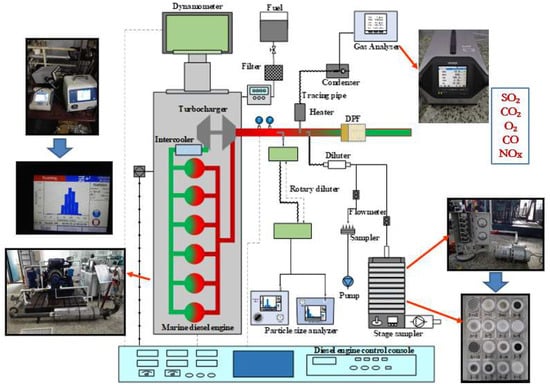
Figure 2.
Schematic diagram of the experimental apparatus.
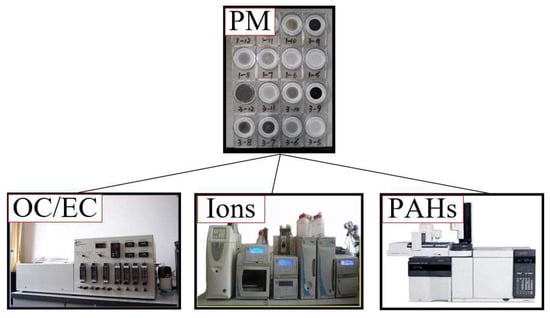
Figure 3.
PM samples and analysis equipment.
The exhaust gas composition was analyzed by a gas analyzer (PG-350, Horiba, Japan), and was used to calculate the engine exhaust flow rate. The particle size analyzer (model 3910, TSI, Shoreview, MN, USA) was used to analyze the particle size distribution, including the mass concentration and number concentration. Total particulate matter was collected using a sampler. Samples in different particle size ranges were collected with a stage sampler (Micro Orifice Uniform Deposit Impactor, MOUDI, 110R, MSP, Coral Gables, FL, USA). The diameter of the quartz filter membrane used to collect particles was 47 mm (QMA 1851-047, Whatman, UK). The particulate matter mass was measured by a microbalance (Sartorius ME 5-F/Mettler XP6, Germany) after 24 h of balance. A thermal–optical carbon analyzer (DRI Model 2001A, USA) was used to analyze elemental and organic carbon (EC and OC). The ion parameters were analyzed by a Dionex I IC (DX-600, ICS-1100, Dionex, Sunnyvale, CA, USA). The GC-MS (Model 7890A-5975C, Agilent, Santa Clara, CA, USA) was used to analyze PAHs. During the experiment, the experimental conditions were first determined according to the requirements. When each working condition was stable, the particles were sampled or directly measured. Each group of particles was sampled at least three times for subsequent weighing and detection, and the average value was used as the experimental result. The particle size analysis was measured directly by the instrument. The average value was taken after data stabilization, and the particle size analyzer recorded data every second. To ensure the reliability of the experimental results, the average of the stable data was used for the results analysis. The lowest detection limit for PAHs ranged from 0.11 to 2.28 ng. The relative standard deviation of the repeated experiment was less than 9.4% for any 1 sample among every 10 samples. For the detection of OC, EC, and ions, the average of the three results of each sample was taken as the result.
2.2. Data Calculation and Analysis
According to the experimental requirements of the marine diesel engines, the experimental validity was judged according to Equation (1), as follows:
where fa denotes the atmospheric factors of the experimental environment. For turbocharged engines, fa is calculated using Equation (2), as follows:
where Ps denotes the dry-air pressure, kPa; Ta denotes the absolute intake air temperature, K. Ps is calculated using Equation (3), as follows:
where Pb denotes total atmospheric pressure, kPa; Ra denotes the relative humidity of the intake air, %; Pa denotes the saturated steam pressure of the intake air, kPa. Pa is calculated using Equation (4), as follows:
where ta denotes intake air temperature in °C.
0.93 ≤ fa ≤ 1.07
The exhaust gas mass flow is calculated using Equation (5), as follows.
where qmew denotes wet exhaust gas mass flow, kg/h; qmf denotes fuel oil mas flow, kg/h; wBET, wALE, wDEL, wEPS denote the contents of C, H, N, and O elements in fuel oil, %wt. Ha denotes the absolute humidity of intake air. ffd denotes the fuel-specific constant of dry exhaust gas, and fc denotes the carbon coefficient. The above three parameters can be obtained using Equation (6), Equation (7), and Equation (8), respectively, as follows:
where denotes the dry CO2 concentration in the exhaust gas, %vol; denotes the dry CO2 concentration in the ambient atmosphere, which is 0.03%vol; denotes the dry CO concentration in the exhaust gas, measured in ppm; and denotes the wet HC concentration in the exhaust gas, measured in ppm.
PM-specific mass can be calculated using Equation (9), as follows:
where Pi denotes the power value in kW and PMmass denotes the PM mass flow. The weighted particulate-specific emission of PM (g/kW·h), used for comparison with the emission limits, can be obtained using Equation (10), as follows:
where denotes the weighting factor of each engine condition. PMmass is calculated using Equation (11), as follows:
where Mf denotes the weighing mass of particles in kg; denotes the gas sampling mass flow rate in kg/h; denotes the sampling time in h; DR denotes the dilution ratio.
2.3. DPF Design and Parameters
The DPF equipment was designed based on the marine four-stroke diesel engine. The filter was the key component and served as the site for capture and regeneration in the DPF. The volume of the filter was mainly related to engine displacement. According to the experience, the DPF carrier volume should be 1.5–2 times the engine displacement. The calculation formula can be described using Equation (12). VDPF denotes the filter volume, and VL denotes the engine displacement.
The displacement of the engine was 9.726 L, and the gas flow velocity was 5 m/s in the filter on the standard condition. The cross-sectional area of the filter can be calculated using Equation (10). In Equation (13), Afilter, Qv, and v denote the filter cross-sectional area, exhaust gas flow, and gas flow velocity, respectively.
The selected DPF was ceramic and the size was Φ270 mm × 310 mm. The final overall dimensions were Φ300 mm × 450 mm, considering the shell cushion and connection mode. The DPF filter parameters are shown in Table 2.

Table 2.
The DPF filter parameters.
3. Results
3.1. Emission Characteristics of Particle Number Parameters
The number concentration and size distribution of the PM from the marine diesel engine are shown in Figure 4. Figure 5 shows the effect of the DPF on the PM number concentration emission characteristics. When the DPF was not used, the first peak value was about 4.5 × 107 #/cm3 at a 100% engine load point. When the DPF was used, the first peak value was about 2.5 × 107 #/cm3. And when the load time increased, there was a decrease by an order of magnitude.
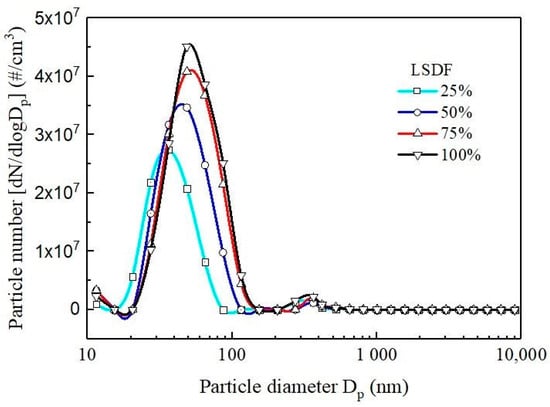
Figure 4.
Characteristics of the particle number and size distribution without DPF.
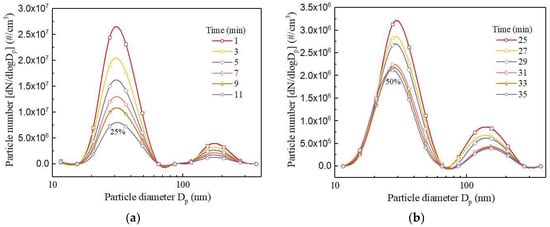
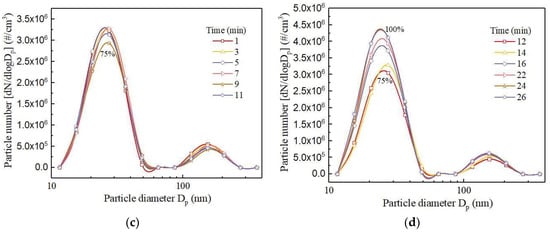
Figure 5.
Characteristics of the particle number and size distribution in the loading process with DPF ((a): 25% load; (b): 50% load; (c): 75% load; (d): from 75% to 100% load).
The starting point of the measurement was the loading start time of the DPF. It can be seen from the figures that the particle size distribution curve range became smaller and the peak value of the curve decreased gradually with the extension of the loading time. In the experiment process, when the time was 25 min, the engine load increased from 25% to 50% (Figure 5a,b), and the above process was the loading stage. At about 35 min, the curve peak tended to stabilize. On this basis, the engine load increased to 75% (Figure 5c), and when the curve peak was stable, the loading process ended. When the engine load continued to rise to 100% (Figure 5d), the loading began again until the peak stabilized.
Figure 6a shows the change in total particle number concentration during the DPF loading process over time. As the loading process progressed, the total number of particulate matter gradually decreased, and the DPF capture efficiency gradually increased. At a load of 50%, the number concentration was 6.8 × 106 #/cm3, and the capture efficiency was 94.4%. When the engine load percentages reached 75% and 100%, the number concentration and efficiency were 9.6 × 106 #/cm3 and 1.3 × 107 #/cm3, with 93.7% and 92.3%, respectively. Compared to a fresh DPF, the capture efficiency was higher after loading. With the increase in load, the total number concentration of particulate matter increased, and the capture efficiency decreased. This was because the content of particulate matter in the fresh DPF (unloaded or regenerated DPF) was very small, and particulate matter was only captured through the micropore unit of the filter body. In this state, the DPF had the lowest capturing efficiency for particulate matter. During the loading process, particles accumulated on the surface of the filter body, reducing the micropore size, which, thus, reduced the passing rate of particles and gradually increased the capturing efficiency of the filter body. When the engine load increased, the exhaust gas flow and particulate matter emission increased through DPF. With the accumulation of particulate matter, the particulate matter emission also tended to stabilize after DPF.
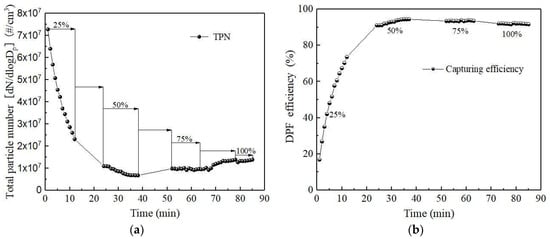
Figure 6.
Change in the total particle number concentration, capturing the efficiency in the loading process over time with DPF ((a): Total particle number; (b): DPF PM capturing efficiency).
Figure 7 shows the influence of DPF on the capturing efficiency of the particle nuclei mode and accumulation mode. The distribution of PM includes the nuclei mode and accumulation mode. Both the nuclei and accumulation mode particles increased with the increased engine load and the nuclei mode changed slowly. The variation in nuclei mode particles was consistent with the previous study [25]. But the accumulation mode particles were slightly different; this may be due to different diesel engine performances. The number of nuclei modes was still higher than that of the accumulation mode and increased with the engine load. The capturing efficiency was higher than that of the nuclear mode. After DPF, the number of exhaust particles was still dominated by nuclei mode particles. The weighted value of PM emitted by the engine under each load after the DPF was 6.88 × 1013 #/kW·h, which was still far higher than the limit of 1 × 1012 #/kW·h stipulated by the European Union.

Figure 7.
Influence of DPF on the particle nuclei mode, accumulation mode, and capturing efficiency.
Figure 8 shows the capture efficiency of PM at different sizes. At loads of 50%, 75%, and 100%, the capture efficiency of particles in the size range of 50 nm gradually increased with the increase in particle size. When the particle size was greater than 50 nm, the capture efficiency decreased first and then increased. In each particle size range, with the increase in load, the capture efficiency decreased as a whole. The DPF can effectively reduce the number concentration of diesel exhaust particles within the main particle size range. For particles smaller than 50 nm, diffusion trapping played a major role, but the diffusion effect had a certain randomness. However, when the hierarchical trapping efficiency curve was near 150 nm, there was a trough, and the trapping efficiency was low, which may be due to the weak trapping effect with the participation of both diffusion and interception, resulting in a decrease in the trapping efficiency within this particle size range.
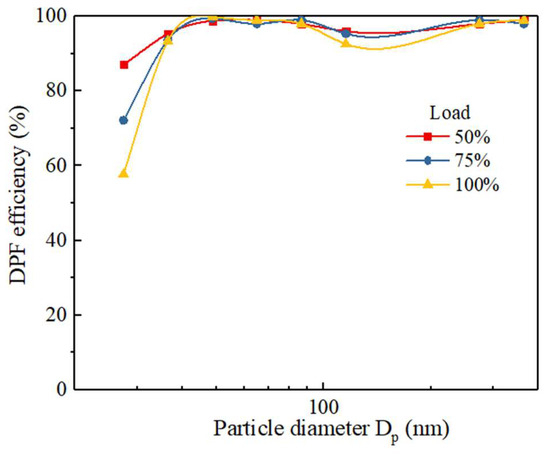
Figure 8.
The efficiency of PM at different sizes.
The capture efficiency of DPF for marine diesel exhaust particles was consistently high, especially for the number concentration of particles in the main particle size range, which was close to 100%. The peak of the particle number concentration curve at the DPF outlet shifted to the left and was still normally distributed. With the increase in particle size, the capture efficiency gradually increased. This was in accordance with the capturing theory, but there will be a certain degree of decrease in the accumulation mode region after the increase, which cannot be explained simply by the capturing theory. This may be because a complex process of particle formation and growth, such as nucleation condensation and accumulation, occurred in the DPF after the particles entered the DPF through the exhaust pipe, rather than simple deposition. Other possible reasons may be that the desorption of impurities—such as particles captured in the DPF or particles attached to the sampling system pipeline—can lead to increased particle emissions in the downstream accumulation mode of the DPF, resulting in a decrease in the capture efficiency.
3.2. Emission Characteristics of Particle Mass Parameters
Figure 9 shows the influence of DPF on particle-specific mass emissions and capturing efficiency. The DPF had a good emission reduction effect on diesel PM mass emission. At loads of 50%, 75%, and 100%, the capture efficiencies were 92.5%, 90.3%, and 89.0%, respectively, and gradually decreased with the increase in load. The PM mass-specific emission rates were 14 mg/kW·h, 23.8 mg/kW·h, and 30.4 mg/kW·h, respectively.
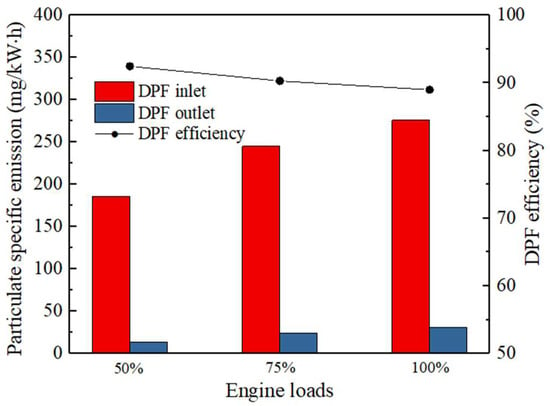
Figure 9.
Influence of the DPF on PM mass-specific emissions and capturing efficiency.
Figure 10 shows the characteristics of PM mass concentration and size distribution at 100% engine load. The peak of the mass concentration distribution curve changes from 300–400 nm to 100–200 nm. The small crest changes from 60–70 nm to 30–40 nm. DPF has a high capturing effect on the particles in the main particle size range.
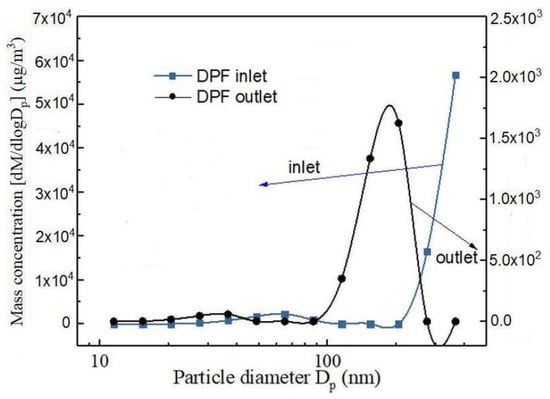
Figure 10.
Characteristics of the particle mass concentration and size distribution before and after DPF at the 100% load point.
Figure 11 shows the comparison between tested values and emission limits with or without DPF. As can be seen from the figure, the specific emission-weighted value of PM after DPF was only 23.3 mg/kW·h, which had a very significant effect on PM emission reduction, can well meet the PM emission limits stipulated by the second phase of regulations formulated by China in inland waters, and meet the marine emission regulations as stipulated by the European Union and US EPA [26,27].
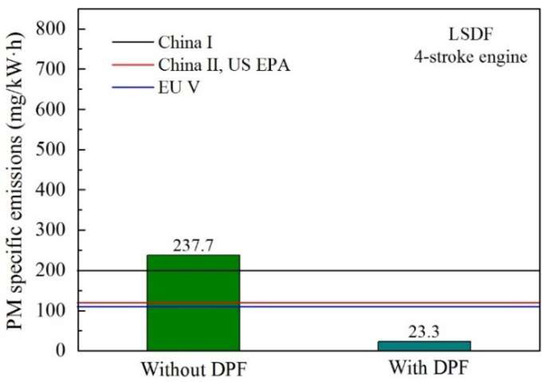
Figure 11.
Comparison between tested values and emission limits with or without DPF.
3.3. Emission Characteristics of OC and EC
DPF had a good capturing effect on diesel exhaust particulate matter, and various components in particulate matter will be reduced to a greater extent. The OC/EC emission characteristics and capturing efficiency are shown in Figure 12. With the increase in the load, the capture efficiency of EC decreased, while the capture efficiency of OC increased. For four-stroke diesel engines, the fuel quality was better than heavy fuel oil, and the main emission was EC. With the increase in engine load, the EC emission increased, and capturing efficiency decreased. The increase in load was accompanied by the increase in exhaust temperature. In the DPF, OC can continue to oxidize at higher temperatures.
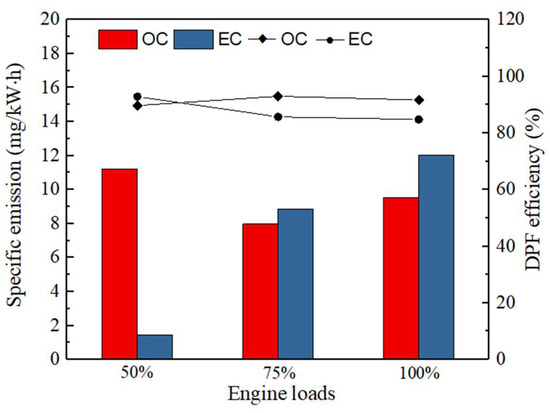
Figure 12.
Influence of DPF on OC and EC in the PM from the diesel engine.
Figure 13 shows the emission characteristics of OC and EC after DPF. When the engine load was 50%, the OC/EC ratio was about 7.8. The removal efficiency of OC was lower, and OC1 still accounted for the main proportion of OC. At 75% and 100% load points, the OC/EC ratio was less than 1. The proportion of OC in carbon composition was reduced, and the proportion of OC1 was also significantly reduced. The reason was that when the load was high, the exhaust temperature also became high. The participation of DOC was significant, so that part of the carbon in the escaping particles was oxidized, and the oxidized part contained more OC1. The proportion of EC1 also increased significantly due to more fuel injection. The reason may also be attributed to the carbon components adsorbed in the DPF after oxidation desorption into the exhaust gas, increasing the proportion of EC1.
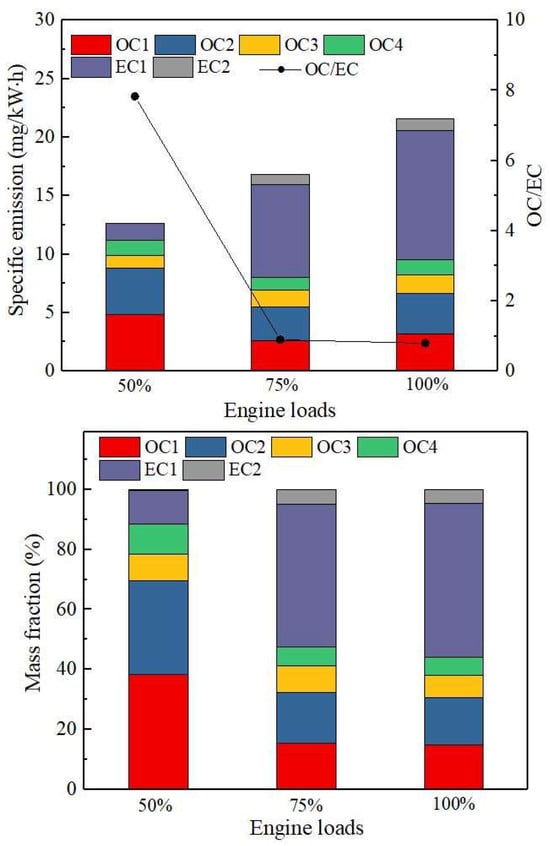
Figure 13.
The specific emissions of OC1–OC4 and EC1–EC3 in PM and their mass fraction percentages in carbon emissions.
Figure 14 shows the size distributions of OC and EC at a 75% load and capturing efficiency with DPF. The particle size distribution curve of OC and EC mass emissions through the DPF outlet shows a bimodal distribution, with the first peak particle size range of 100–180 nm and the second peak particle size range of 320–560 nm. However, unlike the direct exhaust of diesel engines, the two peaks of EC were higher than OC, and the removal efficiency of DPF on EC increased first and then decreased with the increase in particle size. The capture efficiency of nuclei mode particles was the lowest, and with the size increasing, the capture efficiency gradually increased. The capture efficiency of OC also gradually increased with the increase in particle size, and the overall capture efficiency was above 90%. With the increase in particle size, especially in the coarse particle mode, the contents of OC and EC were significantly lower than in the nuclei mode, mainly because DPF had a higher capture efficiency for large particles. The DPF can effectively remove particle carbon components in the exhaust gas.
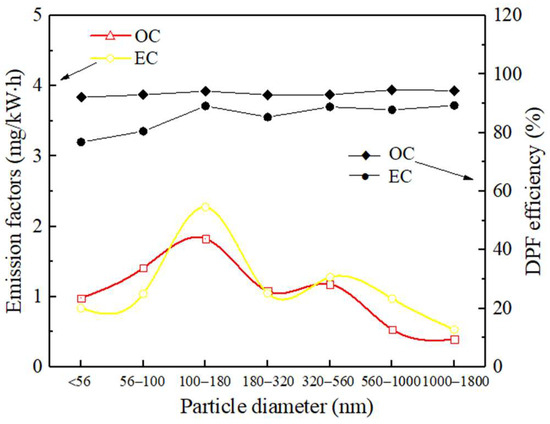
Figure 14.
Size distribution of OC and EC in PM at a 75% load point after DPF and capture efficiency.
3.4. Emission Characteristics of Ions in PM
Figure 15 shows the emission characteristics of water-soluble ions after DPF. SO42− was still the ion with the highest content, followed by NH4+, NO3−, Na+, NO2−, and Cl−, whose reduction efficiencies were basically consistent with the removal efficiency of PM, while the contents of F−, Ca2+, Mg2+, and K+ were very small. The particle’s non-flammability in the emissions directly affected the pressure loss and regeneration efficiency of DPF, such as sulfate, mainly from the combustion of lubrication oil and sulfur in the fuel [28]. Compared with vehicle fuel, marine fuel had high sulfur content, poor quality, and relatively more impurities. In addition to the use of better-quality fuel, a special design for marine diesel engine DPF is also a direction that can be optimized.
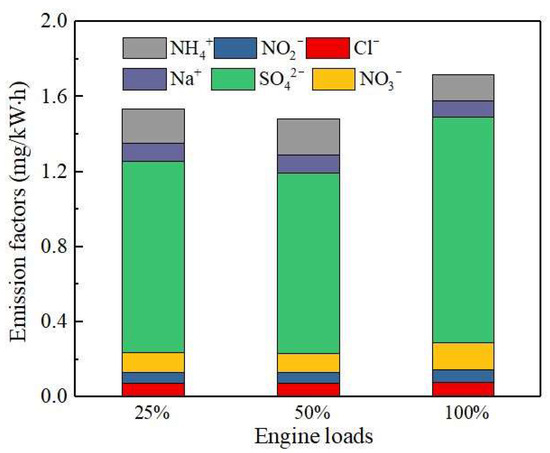
Figure 15.
Emission characteristics of water-soluble ions in PM after DPF.
3.5. Emission Characteristics and Toxicity of PAHs in PM
The content of PAHs in particulate matter was relatively low, but it was the main harmful substance, and a minimal amount of content can cause great harm to human health. PAHs mainly exist in OC, and part of PAHs can be removed when the main OC component of particulate matter is removed. At the same time, in the active regeneration process of DPF, the higher temperature will cause the combustion of gaseous PAHs. PAHs are highly toxic and carcinogenic, and their emissions are important indices used to measure pollutant emissions from ships. Figure 16 shows the comparison of PAH emissions under a 75% diesel engine load, and Figure 17 shows the removal efficiency of each PAH. It can be seen from the results that the highest emission value was for Pyr, followed by Flua, Phe, and Chr. And the total emission of various PAHs was about 83 μg/kW·h. DPF also had a good removal efficiency for PAH emissions. The removal efficiency of most PAHs was above 60%, and the removal efficiencies of BaP, BaA, and Chr were close to 90%.
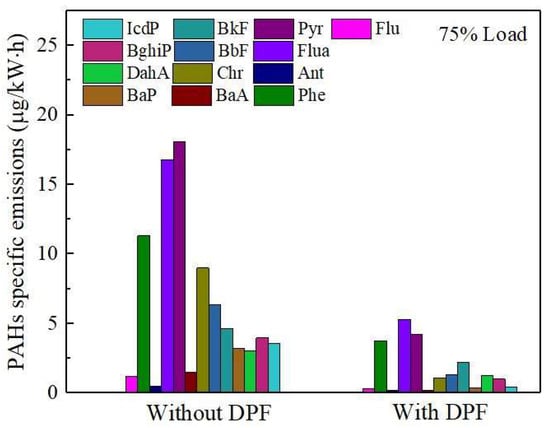
Figure 16.
Effect of DPF on PAH emissions.
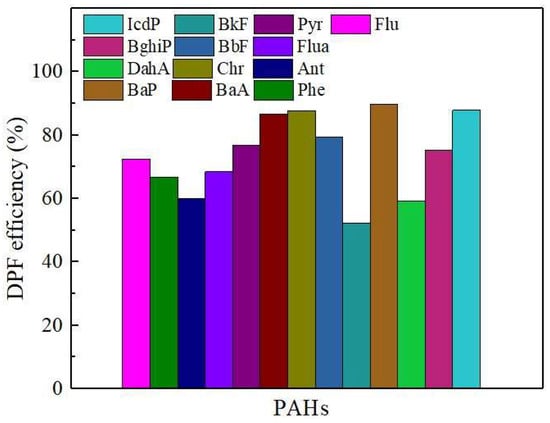
Figure 17.
Removal efficiency percentages of PAHs with DPF.
The particle size distribution of PAHs was also very important. The smaller the particle size, the easier it was to inhale by the human lung. As shown in Figure 18, when DPF was not used, the particle size distribution of PAHs presented an obvious multi-peak form. The peak value was highest in the range of 100–180 nm, followed by the range of 320–560 nm. There was also a certain peak in the range of less than 56 nm because it contained relatively larger molecular-weight PAHs, mainly from the combustion process of fuel. After the installation of DPF, PAH emissions in each particle size range decreased as a whole. The particle size distribution curve was close to the level, and the multi-peak feature was not obvious. It can be seen from the particle size distribution curve of PAH removal efficiency that the removal efficiency of PAHs in the large particle size range was slightly higher, and that in the range of 56–100 nm was the lowest with a small particle size.
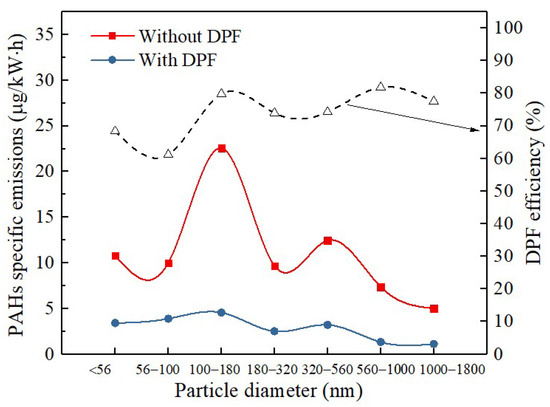
Figure 18.
Effect of DPF on the size distribution of PAHs.
The toxicity of PAHs can be evaluated using the toxicity equivalent factor method. In this method, BaP, which has strong carcinogenic toxicity, was used as the primary agent. Table 3 shows the toxicity equivalent factors of 16 types of optimal control PAHs, and Equation (14) shows the calculation formula of PAH toxicity.

Table 3.
TEFs of 16 PAHs.
As shown in Table 4, DPF can effectively reduce the toxicity of each PAH, especially BaP and DahA, which are highly toxic. The total toxic concentration of PAHs was also reduced from 1170 to 310 ng/m3. The use of DPF can greatly reduce the carcinogenic risk to crew and port personnel.

Table 4.
BEQs of 16 PAHs with or without DPF (ng/m3).
DPF demonstrated good performance and applicability, effectively reducing particle mass, number emissions, and the chemical compositions of four-stroke diesel engines. The results can meet marine emission regulations. However, there were many types of marine diesel oil, including various minerals and sulfur elements, and DPF was limited to mass production and unification. Therefore, compared to automotive diesel engines, when developing marine DPF, appropriate DPF should be selected according to the PM emission and particle size distribution characteristics of different fuel conditions to achieve the best capture and regeneration performance. In practical applications, special customization should be made for different diesel engines with different diesel qualities.
4. Conclusions
DPF was proven to be an effective method for removing particulate matter from marine four-stroke diesel engines, playing an important role in the sustainable development of the shipping industry. In this study, marine DPF was studied in depth, including the capture efficiency and the effect on the chemical composition of particulate pollutants. The main conclusions are as follows:
- DPF demonstrated high removal efficiency for the total PM number and mass emissions.
- Compared to the accumulation mode, the particle capturing efficiency of the nuclei mode was lower, mainly due to the particle size and the desorption process.
- DPF demonstrated a high removal effect on different chemical components, such as OC, EC, and PAHs.
- DPF can effectively reduce particulate matter toxicity.
- In the design of marine DPF, the pore size of the DPF filter body should be slightly larger.
Author Contributions
Conceptualization, J.Z. (Jinxi Zhou); methodology, J.Z. (Jinxi Zhou); validation, J.Z. (Junling Zhang); formal analysis, G.J.; investigation, J.Z. (Jinxi Zhou); resources, J.Z. (Jinxi Zhou); data curation, G.J. and K.X.; writing—original draft preparation, J.Z. (Jinxi Zhou); writing—review and editing, J.Z. (Jinxi Zhou); visualization, K.X.; supervision, J.Z. (Junling Zhang); project administration, J.Z. (Jinxi Zhou); funding acquisition, J.Z. (Jinxi Zhou). All authors have read and agreed to the published version of the manuscript.
Funding
This research was funded by the WUST Research Program (no. KJRC2022010) from Weifang University of Science and Technology; and the Shandong Provincial Natural Science Foundation of China (no. ZR2022QE261).
Institutional Review Board Statement
Not applicable.
Informed Consent Statement
Not applicable.
Data Availability Statement
Data are available from the authors upon reasonable request.
Conflicts of Interest
The authors declare no conflicts of interest.
Abbreviations
| DPF | diesel particulate filter |
| PM | particulate matter |
| OC | organic carbon |
| EC | elemental carbon |
| PAHs | polycyclic aromatic hydrocarbons |
| LNG | liquefied natural gas |
| NTP | non-thermal plasma |
| SCR | selective catalytic reduction |
References
- Gunnarsson, B. Recent ship traffic and developing shipping trends on the Northern Sea Route-Policy implications for future arctic shipping. Mar. Policy 2021, 124, 104369. [Google Scholar] [CrossRef]
- Herdzik, J. Decarbonization of Marine Fuels-The Future of Shipping. Energies 2021, 14, 4311. [Google Scholar] [CrossRef]
- Yoo, B.Y. Economic assessment of liquefied natural gas (LNG) as a marine fuel for CO2 carriers compared to marine gas oil (MGO). Energy 2017, 121, 772–780. [Google Scholar] [CrossRef]
- Fan, C.Y.; Wei, J.J.; Huang, H.Z. Chemical feature of the soot emissions from a diesel engine fueled with methanol–diesel blends. Fuel 2021, 297, 120739–120747. [Google Scholar] [CrossRef]
- IMO MEPC. circ. 723. Information on North American Emission Control Area (ECA) Under Marpol Annex VI. 2010. Available online: https://www.imo.org/en/OurWork/Environment/Pages/Index-of-MEPC-Resolutions-and-Guidelines-related-to-MARPOL-Annex-VI.aspx (accessed on 13 May 2010).
- Breitling, U. Sustainable shipping and port development. ASEAN-Ger. Tech. Coop. 2010, 1, 2–4. [Google Scholar]
- Wilailak, S.; Yoo, B.H.; Kim, Y.; Lee, C.J. Parametric analysis and design optimization of wet SOx scrubber system in marine industry. Fuel 2021, 304, 121369. [Google Scholar] [CrossRef]
- Fridell, E.; Kent, S. Measurements of abatement of particles and exhaust gases in a marine gas scrubber. J. Eng. Marit. Environ. 2016, 1, 154–162. [Google Scholar] [CrossRef]
- Byeong, L.; Raj, M.B. Evaluating the performance of a turbulent wet scrubber for scrubbing particulate matter. J. Aire Manag. Assoc. 2013, 5, 499–506. [Google Scholar]
- Tu, S.E.; Shen, T.; Guo, M.S. Experiment on PM Capture and Regeneration for marine diesel engine. Nav. Archit. Ocean. Eng. 2023, 39, 24–28. [Google Scholar]
- Zhang, Z.Q.; Tian, J.; Li, J.T.; Cao, C.; Tan, D.L. The development of diesel oxidation catalysts and the effect of sulfur dioxide on catalysts of metal-based diesel oxidation catalysts: A review. Fuel Process. Technol. 2022, 233, 107317. [Google Scholar] [CrossRef]
- Luo, J.B.; Tie, Y.H.; Tang, L.F. Effect of regeneration method and ash deposition on diesel particulate filter performance: A review. Environ. Sci. Pollut. Res. 2023, 30, 45607–45642. [Google Scholar] [CrossRef] [PubMed]
- Takuya, K.; Keiichiro, Y. Pilot-scale experiments of continuous regeneration of ceramic diesel particulate filter in marine diesel engine using nonthermal plasma-induced radicals. IEEE Trans. Ind. Appl. 2012, 5, 1649–1656. [Google Scholar]
- Nicholas, R.; Gysel, R.L.; Russell, W.A. Impact of aftertreatment technologies on the in-use gaseous and particulate matter emissions from a tugboat. Energy Fuels 2015, 8, 546–551. [Google Scholar]
- Yang, Z.Y.; Chen, H.W.; Li, C.X.; Guo, H.; Tan, Q.M. Performance Test and Structure Optimization of a Marine Diesel Particulate Filter. Energies 2023, 16, 4336. [Google Scholar] [CrossRef]
- Tan, D.L.; Dong, R.; Zhang, Z.Q. Multi-objective impact mechanism on the performance characteristic for a diesel particulate filter by RF-NSGA III-TOPSIS during soot loading. Energy 2024, 286, 129582. [Google Scholar] [CrossRef]
- Duan, L.S.; Tan, P.Q.; Yin, Y.F. Effect of ash on temperature and particulate emission characteristics of diesel particulate filter during active regeneration. J. Clean. Prod. 2023, 426, 138980. [Google Scholar] [CrossRef]
- Jang, J.; Lee, Y.; Kwon, O. Comparison of fuel efficiency and exhaust emissions between the aged and new DPF systems of Euro 5 diesel passenger car. Int. J. Automot. Technol. 2017, 18, 751–758. [Google Scholar] [CrossRef]
- Shi, Y.X.; Cai, Y.X.; Wang, J.; Pu, X.Y.; Gu, L.B. Influence of PM Size Distribution and Ingredients on DPF Regeneration by Non-thermal Plasma Technology. Plasma Chem. Plasma Process. 2017, 37, 451–464. [Google Scholar] [CrossRef]
- Qi, B.Y.; Li, Z.G.; Lou, D.M.; Zhang, Y.H. Experimental investigation on the effects of DPF Cs-V-based non-precious metal catalysts and their coating forms on non-road diesel engine emission characteristics. Environ. Sci. Pollut. Res. 2022, 30, 9401–9415. [Google Scholar] [CrossRef]
- Manh, D.N.; Quang, V.T.; Luong, N.T. A simulation and experiment study on the emission reduction potential of light-duty diesel engine retrofitted with an after-treatment system: A case study. Energy Sources Part A Recovery Util. Environ. Eff. 2024, 46, 674–688. [Google Scholar]
- Mustaqiman, A.N.; Santos, J.P. Evaluating the performance of particle oxidation catalyst for construction equipment. Atmos. Pollut. Res. 2023, 14, 101947. [Google Scholar] [CrossRef]
- Wu, D.; Cheng, A.Y.; Shao, Y.K. More Than Concentration Reduction: Contributions of Oxidation Technologies to Alleviating Aerosol Toxicity from Diesel Engines. Environ. Sci. Technol. Lett. 2022, 9, 280–285. [Google Scholar] [CrossRef]
- Smith, J.D.; Ruehl, C. Real-time particulate emissions rates from active and passive heavy-duty diesel particulate filter regeneration. Sci. Total Environ. 2019, 680, 132–139. [Google Scholar] [CrossRef] [PubMed]
- Zhang, Y.H.; Lou, D.M.; Tan, P.Q.; Hu, Z.Y.; Fang, L. Effect of catalyzed diesel particulate filter and its catalyst loading on emission characteristics of a non-road diesel engine. J. Environ. Sci. 2023, 126, 794–805. [Google Scholar] [CrossRef]
- GB 15097-2016:1-81; MEE. Limits and Measurement Methods for Exhaust Pollutants from Marine Engines (CHINA I, II). Standards Press of China: Beijing, China, 2016.
- EPA. RESOLUTION MEPC.328(76). USA. 2021. Available online: https://www.epa.gov/system/files/documents/2024-05/mepc-328-76.pdf (accessed on 1 July 2022).
- Shim, B.J.; Park, K.S.; Koo, J.M.; Nguyen, M.S.; Jin, S.H. Estimation of Soot Oxidation Rate in DPF under Carbon and Non-carbon Based Particulate Matter Accumulated Condition. Int. J. Automot. Technol. 2013, 14, 207–212. [Google Scholar] [CrossRef]
Disclaimer/Publisher’s Note: The statements, opinions and data contained in all publications are solely those of the individual author(s) and contributor(s) and not of MDPI and/or the editor(s). MDPI and/or the editor(s) disclaim responsibility for any injury to people or property resulting from any ideas, methods, instructions or products referred to in the content. |
© 2024 by the authors. Licensee MDPI, Basel, Switzerland. This article is an open access article distributed under the terms and conditions of the Creative Commons Attribution (CC BY) license (https://creativecommons.org/licenses/by/4.0/).